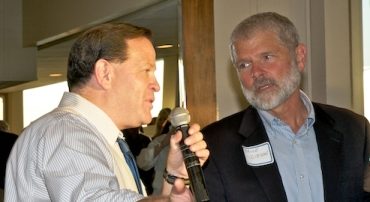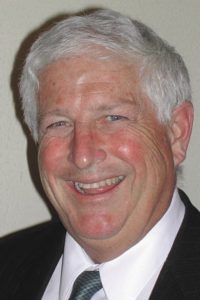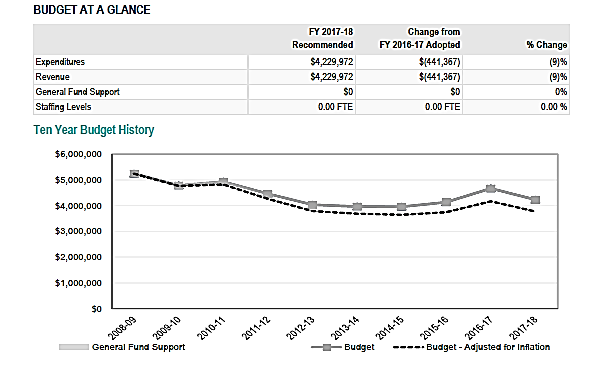Luring cities into the Gibson, Hill swamp
May 25, 2017
OPINION by MICHAEL F. BROWN
Second District Supervisor Bruce Gibson has launched a stinky political swamp gas attack on the three-member board majority, supervisors Arnold, Compton and Peschong. Gibson sent a letter to the mayors of the county’s seven cities exhorting them to engage their respective city councils in an effort to disrupt the county’s 2017-18 fiscal year budget adoption process, which takes place on June 12 through 14.
As background, remember that voters – almost 80 percent – of the unincorporated Paso Basin combined last year to defeat the formation of the ill-fated AB 2453 water management district, bill that was vigorously supported by Supervisors Gibson and Hill.
After the defeat, the Gibson and Hill promised retribution, suggesting that they would induce the State Department of Water Resources to take over the basin management and have it impose harsh regulations and steep fees on the errant overliers. It turned out that the state has no desire to manage local water basins, and that a locality (city or county) would have to willfully and flagrantly refuse to manage a basin for the state to actually take over.
As a result, the two vindictive supervisors switched their strategy to a force play in which they would have the county compel unincorporated area residents, who do not reside within an existing or newly formed water management district, to tax themselves to pay the costs of the county managing their groundwater obligations under the State Groundwater Management Act of 2014 (SGMA).
Hill and Gibson schemed that if the people refused to vote in a new tax, they could punish them by forcing them into the clutches of the state bureaucrats.
Supervisors Arnold, Compton, and Peschong said, wait a minute, the county’s long existing flood control/water district already has groundwater management authority and now has to comply with mandated and unfunded SGMA compliance requirements. Moreover, the county water district has been taxing unincorporated rural overliers for years and has provided them little or no benefit. They reasoned, let the district conduct and fund the planning (a two-year exercise) for meeting state SGMA requirements. If there are costs to implement the plans such as building dams, spreading basins, building pipelines, or enforcing rationing, then hold a funding vote based on the specific costs in an approved plan.
Gibson and Hill contrived the specious presumption that all city residents and independent water district residents might be paying for SGMA planning through their monthly water bills. Since the County Water district is funded by a small sliver of the property tax paid by everyone, Hill and Gibson leaped to the proposition that that these largely urban dwellers would be double taxed.
Gibson is now attempting to stir up the seven city councils to oppose inclusion of funding for SGMA planning for unincorporated areas that are not served by a water management district. These funds are included in the proposed draft 2017-18 annual budget.
The fact is that the urban residents are paying for actual water, in their water bills. City water departments and independent water districts may incidentally use a small portion of their water revenues to fund long range water planning. SGMA is a form of long range strategic water planning.
Gibson’s false reasoning political ploy is based on his theory that rural residents on wells are not paying for their water since they do not pay bills to a water utility. The fact is that they pay for their water by drilling wells, maintaining wells, and paying energy costs for pumping. They too are already taxed by the county water district for strategic water planning, which now includes SGMA.
What difference does it make, in this case, if you pay for your water in a monthly utility bill or in the form of the costs of developing and operating your own well?
Gibson further asserts that new budget appropriations for SGMA planning by the county will erode other services as the new funding will displace existing or increased funding for other services such as “public safety, affordable housing, homeless services, and mental health and addiction programs.”
Of course, the county already has a special tax on construction of market rate homes to fund affordable housing. It will put $11.7 million of general fund dollars, mostly unrequired overmatch, into the $69.7 million Behavioral Health Department budget which is supposed to be primarily funded by Med-Cal and other federal and state tax dollars, which you annual pay in your income taxes and sales taxes.
In fact the new proposed 2017-18 budget is already on the street and shows increases in the very general fund areas that Gibson said would be shorted.
· Fire Department, up $1,355,000
· District Attorney, up $700,000
· Probation, up $562,000
· Behavioral Health, up $292, 000
· Social Services, up $1,575,000
· Public Health, up $762,000
Remember, these are new dollars which come from the property tax, general sales tax, and transient occupancy tax. Gibson didn’t mention that the new budget contains $12.4 million in salary and benefit increases. Apparently he doesn’t think these erode the county’s ability to provide services.
Gibson’s claim that the funding of SGMA planning will hurt the homeless and housing programs funded by the general fund is ludicrous. Except for some token grants to private not-for-profit social service agencies, the county relies almost entirely on federal funds for its homeless and related housing programs. As the budget document point outs in its Community Development Department presentation:
Note that, per the chart below, the county is investing zero general fund dollars in these programs, now and historically. They are primarily funded by federal taxes.
By way of trivialization, Gibson’s letter states that based on his $2 million price estimate for SGMA planning, the cost to city residents would be $7.14 per capita for the first year. This is less than the price of two Starbuck’s café lattes ($4.25 apiece).
For whatever reason the fake principle , which he is now asserting, was not an issue for Gibson when the county expended $1 million dollars of its water district funding to attempt to force the AB 2453 water district upon residents of the Paso Basin. Nor did he complain when the county contracted in 2004 to pay $1.2 million per year in debt service for unallocated Nacimiento aqueduct water which was being held on behalf of contracting cities and water utility districts.
It is estimated that over 12 years, and prior to the cities and districts contracting for the unused water allocations, the county paid $14 million out of the county water district budget. Similarly rural unincorporated residents have paid for construction and operation of the Central Coast Aqueduct from which they do not receive any benefit.
Worse yet, how many county water district and general fund dollars has the county expended in legal fees and experts on attempting to defeat its own citizens who are defending their constitutional water rights through the Paso Robles Water Basin Quiet Title Acton? It could end up amounting to hundreds of thousands or more.
Gibson’s whole effort is a cheesy red herring charade. Hopefully the city councils will not be suckered into the Gibson-Hill swamp.
Mike Brown is the government affairs director of the Coalition of Labor Agriculture and Business (COLAB) of San Luis Obispo County. He had a 42-year career as a city manager and county executive officer in four states including California. He can be reached at mike@colabslo.org.











The comments below represent the opinion of the writer and do not represent the views or policies of CalCoastNews.com. Please address the Policies, events and arguments, not the person. Constructive debate is good; mockery, taunting, and name calling is not. Comment Guidelines